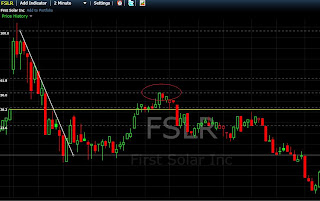A note on chart patterns: they work best on 5 min, 30 min, hourly, daily charts. Anything too short term and the patterns don't mean much.
 Head and Shoulders
Head and ShouldersHead and shoulders is a reversal pattern that, when formed, signals the security is likely to move against the previous trend. There are two versions of the head-and-shoulders pattern. The head-and-shoulders top is a signal that a security's price is set to fall, once the pattern is complete, and is usually formed at the peak of an upward trend. The second version, the head-and-shoulders bottom (also known as inverse head and shoulders), signals that a security's price is set to rise and usually forms during a downward trend.
Symmetrical Triangle
The symmetrical triangle is mainly considered to be a continuation pattern that signals a period of consolidation in a trend followed by a resumption of the prior trend. It is formed by the convergence of a descending resistance line and an ascending support line. The two trendlines in the formation of this triangle should have a similar slope converging at a point known as the apex.
The price of the security will bounce between these trendlines, towards the apex, and typically breakout in the direction of the prior trend. Ascending Triangle
The ascending triangle is a bullish pattern, which gives an indication that the price of the security is headed higher upon completion. The pattern is formed by two trendlines: a flat trendline being a point of resistance and an ascending trendline acting as a price support.
Descending Triangle
The descending triangle is the opposite of the ascending triangle in that it gives a bearish signal to chartists, suggesting that the price will trend downward upon completion of the pattern. The descending triangle is constructed with a flat support line and a downward-sloping resistance line.
Double Top
The double-top pattern is found at the peaks of an upward trend and is a clear signal that the preceding upward trend is weakening and that buyers are losing interest. Upon completion of this pattern, the trend is considered to be reversed and the security is expected to move lower.
Put a long order slightly above resistance and a short order below support (support line is where the trends bottoms out after top #1)
Double Bottom is simply the opposite of this.
The Flag
The flag pattern forms what looks like a rectangle. The rectangle is formed by two parallel trendlines that act as support and resistance for the price until the price breaks out. In general, the flag will not be perfectly flat but will have its trendlines sloping.
In general, the slope of the flag should move in the opposite direction of the initial sharp price movement; so if the initial movement were up, the flag should be downward sloping.
The buy or sell signal is formed once the price breaks through the support or resistance level, with the trend continuing in the prior direction. This breakthrough should be on heavier volume to improve the signal of the chart pattern. Island Gap Reversal
One of the most well-known gap patterns is the island reversal, which is formed by a gap followed by flat trading and then confirmed by another gap in the opposite direction. This pattern is a strong signal of a top or bottom in a trend, indicating a coming shift in the trend.
One of the most well-known gap patterns is the island reversal, which is formed by a gap followed by flat trading and then confirmed by another gap in the opposite direction. This pattern is a strong signal of a top or bottom in a trend, indicating a coming shift in the trend.
